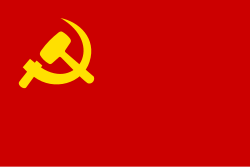
Back الدرب الساطع Arabic الحزب الشيوعى فى بيرو (الدرب المضىء) ARZ Sendero Luminoso AST Сэндэра Луміноса Byelorussian Сендеро Луминосо Bulgarian Strollad Komunour Perou (Gwenodenn Skedus) Breton Partit Comunista del Perú - Sendero Luminoso Catalan Světlá stezka Czech Sendero Luminoso Welsh Perus Kommunistiske Parti Danish
Communist Party of Peru Partido Comunista del Perú | |
|---|---|
 | |
| Abbreviation | PCP (official) PCP-SL (unofficial) |
| Leaders |
|
| Founder | Abimael Guzmán |
| Founded | 1969 (de facto) |
| Split from | Peruvian Communist Party – Red Flag |
| Succeeded by | |
| Armed wing | People's Liberation Army |
| Ideology | |
| Political position | Far-left |
| International affiliation |
|
| Colors | Red |
| Slogan | ¡Viva la Guerra Popular! ¡Guerra Popular hasta el comunismo! ("Long live the People's War! People's War until communism!") |
| Party flag | |
 | |
The Shining Path (Spanish: Sendero Luminoso, SL), self-named the Communist Party of Peru (Partido Comunista del Perú, abbr. PCP), is a far-left political party and guerrilla group in Peru, following Marxism–Leninism–Maoism and Gonzalo Thought. Academics often refer to the group as the Communist Party of Peru – Shining Path (Partido Comunista del Perú – Sendero Luminoso, abbr. PCP-SL) to distinguish it from other communist parties in Peru.
When it first launched its "people's war" in 1980, the Shining Path's goal was to overthrow the government through guerrilla warfare and replace it with a New Democracy. The Shining Path believed that by establishing a dictatorship of the proletariat, inducing a cultural revolution, and eventually sparking a world revolution, they could arrive at full communism. Their representatives stated that the then-existing socialist countries were revisionist, and the Shining Path was the vanguard of the world communist movement. The Shining Path's ideology and tactics have influenced other Maoist insurgent groups such as the Communist Party of Nepal (Maoist Centre) and other Revolutionary Internationalist Movement-affiliated organizations.[4]
The Shining Path has been widely condemned for its excessive brutality, including violence deployed against peasants, such as the Lucanamarca massacre, as well as for its violence towards trade union organizers, competing Marxist groups, elected officials, and the general public.[5] The Shining Path is regarded as a terrorist organization by the government of Peru, along with Japan,[6] the United States,[7] the European Union,[8] and Canada,[9] all of whom consequently prohibit funding and other financial support to the group.
Since the capture of Shining Path founder Abimael Guzmán in 1992 and of his successors Óscar Ramírez ("Comrade Feliciano") in 1999 and Eleuterio Flores ("Comrade Artemio") in 2012, the Shining Path has declined in activity.[10][11] The main remaining faction of the Shining Path, the Militarized Communist Party of Peru (MPCP),[c] is active in the VRAEM region of Peru, and it has since distanced itself from the Shining Path's legacy in 2018 in order to maintain the support of peasants previously persecuted by the Shining Path.[11][12][13] In addition to the MPCP, the Communist Party of Peru – Red Mantaro Base Committee (PCP-CBMR) has been operating in the Mantaro Valley since 2001, while the Communist Party of Peru – Huallaga Regional Committee (PCP-CRH)[d] was active at the Huallaga region from 2004 until Comrade Artemio's capture in 2012.[14]
- ^ "La justicia peruana disuelve el ala política de Sendero Luminoso y condena a Elena Iparraguirre". Radio France Internationale. 29 October 2024.
- ^ "Fudepp: la nueva fachada del Movadef en cuatro claves". El Comercio. 28 September 2016.
- ^ "Sendero Luminoso sufre deserciones por estrategia militar y policial en el Vraem". gob.pe. Gobierno del Perú. 21 February 2020. Retrieved 27 May 2021.
- ^ Maske, Mahesh. "Maovichar", in Studies in Nepali History and Society, Vol. 7, No. 2 (December 2002), p. 275.
- ^ Burt, Jo-Marie (October 2006). "'Quien habla es terrorista': The political use of fear in Fujimori's Peru". Latin American Research Review. 41 (3): 38. doi:10.1353/lar.2006.0036.
- ^ "MOFA: Implementation of the Measures including the Freezing of Assets against Terrorists and the Like". Archived from the original on 6 April 2013. Retrieved 21 November 2013.
- ^ "Country Reports on Terrorism 2020". U.S. Department of State. December 2021. pp. 309–10.
- ^ Council Common Position 2005/936/CFSP. Archived 22 November 2011 at the Wayback Machine. 14 March 2005. Retrieved 13 January 2008.
- ^ Government of Canada. "Listed Entities" Archived 19 November 2006 at the Wayback Machine. Retrieved 11 June 2009.
- ^ Rochlin 2003, p. 3.
- ^ a b c Robbins, Seth (4 September 2020). "Peru in Familiar Stalemate With Shining Path Rebels". InSight Crime. Retrieved 3 December 2020.
- ^ a b Stone, Hannah (27 March 2017). "US Indicts Shining Path Rebels as Drug War Focus Shifts to Peru". InSight Crime. Retrieved 4 December 2020.
- ^ a b Gorder, Gabrielle (23 September 2019). "Peru's Shining Path Plots Unlikely Return to Power". InSight Crime. Retrieved 4 December 2020.
- ^ "Sendero Luminoso desaparece del Huallaga tras captura de sucesor de "Artemio"". Andina. 9 December 2013.
Cite error: There are <ref group=lower-alpha> tags or {{efn}} templates on this page, but the references will not show without a {{reflist|group=lower-alpha}} template or {{notelist}} template (see the help page).
© MMXXIII Rich X Search. We shall prevail. All rights reserved. Rich X Search